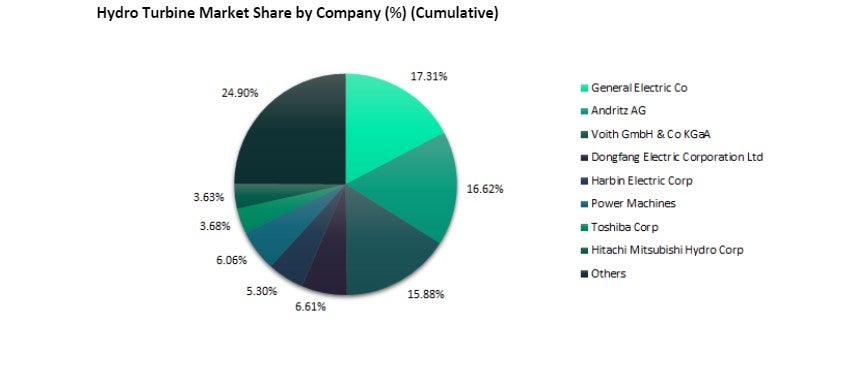Hydropower is one of the most widely used power-generating sources. Even though fossil fuels dominate electricity generation across the world, more than 60 countries use hydropower to meet the majority of their electricity needs.
Why Hydropower Is the Most Popular Non-Polluting Source of Energy
For reasons which include its ability to instantaneously respond to changing electricity demand, as well as water management and flood control, hydropower is the most popular non-polluting source of electricity generation in the world. The cumulative installed capacity for hydropower was 1,356GW in 2021.
Asia-Pacific: The Dominant Region in Hydropower Capacity
By region, Asia-Pacific accounted for 45% of the global cumulative installed capacity of hydropower in 2021, dominated by China with a cumulative capacity of 390.9GW. Most of the largest active hydropower plants in the world are in China and most of the largest upcoming hydropower plants are also either in China or are being built by Chinese companies in other countries including Pakistan, Congo, and Myanmar. India, Japan, and Vietnam are the next largest countries in Asia-Pacific. Europe is a distant second and holds a 23% share of the global hydropower capacity.
Due to the faster development of other renewable technologies, the share of hydropower within the total generation capacity is expected to decline to 13% in 2035. However, in absolute terms hydropower will continue to grow, especially in Asia-Pacific and the Middle East and Africa, which account for 55% of the global upcoming hydropower capacity.
Major Hydro Turbine Manufacturers: Market Leaders and Key Players
The major hydro turbine manufacturers in the hydro turbine market include General Electric Co, Andritz AG, Voith GmbH & Co KGaA, Dongfang Electric Corporation Ltd, Harbin Electric Corp, Power Machines, Toshiba Corp, and Hitachi Mitsubishi Hydro Corp. These hydro turbine companies together hold more than a 75% share of the cumulative installation in the global hydro turbine market with the remaining shared by local and other international players.
Other Notable Suppliers in the Global Hydro Turbine Market
Other significant suppliers are Fuji Electric Co Ltd, Tyazhmash, Zhefu Holding Group Co Ltd, Gammon India Ltd, IMPSA SA, UCM Resita SA, Ansaldo Energia SpA, and Dongfang Electrical Machinery Co Ltd.

Finding the best hydro turbine manufacturer
Power Technology has listed leading manufacturers of hydro turbines based on both its experience in the sector and research carried out by GlobalData.
The information contained within the download document is designed for production managers, procurement managers, maintenance managers, quality control managers, marketing managers, research & development managers, and supply chain managers, and the many other roles responsible for the purchase of hydro turbines.
The free Buyers Guide is available to download and contains detailed information on the suppliers and their product lines, alongside contact details to aid your purchasing decision.
FAQs
What role do hydro turbines play in power generation?
Hydro turbines convert the kinetic energy of flowing water into mechanical energy, which is then used to generate electricity. They are a vital component of hydropower plants, supporting both large-scale electricity production and smaller applications, such as localised energy systems. Hydro turbines offer a renewable energy source that helps reduce reliance on fossil fuels, making them key to clean energy solutions worldwide.
What types of hydro turbines are commonly used?
The two primary types of hydro turbines are reaction and impulse turbines. Reaction turbines, like Kaplan and Francis turbines, are used in low- to medium-head applications and operate fully submerged in water. Impulse turbines, such as Pelton wheels, are used in high-head environments where water is delivered in jets, and only the moving parts of the turbine interact with the water. The choice of turbine depends on the site’s head (water height) and flow rate.
How do hydro turbines contribute to grid stability?
Hydro turbines are highly flexible in power generation. They can rapidly adjust their output to respond to fluctuating demand, making them an essential part of maintaining grid stability. Their ability to quickly ramp up or down electricity generation allows them to complement intermittent renewable energy sources like wind and solar.
What are the environmental benefits of hydro turbines?
Hydro turbines generate electricity without emitting greenhouse gases, making them a sustainable energy solution. Hydropower plants often serve dual purposes, such as water management for irrigation or flood control. However, the environmental impact of constructing large-scale dams must be carefully managed, as it can affect ecosystems and local communities.
Who are the leading manufacturers of hydro turbines?
Leading manufacturers include General Electric, Andritz, Voith, and Dongfang Electric Corporation, who dominate the market with their cutting-edge technology and large-scale production capabilities. These companies provide a range of hydro turbines for various applications, from small-scale hydroelectric systems to large power plants.
Note: GlobalData, the leading provider of industry intelligence, is the parent company of Power-Technology.com and provided the underlying data, research, and analysis used to produce this article.


